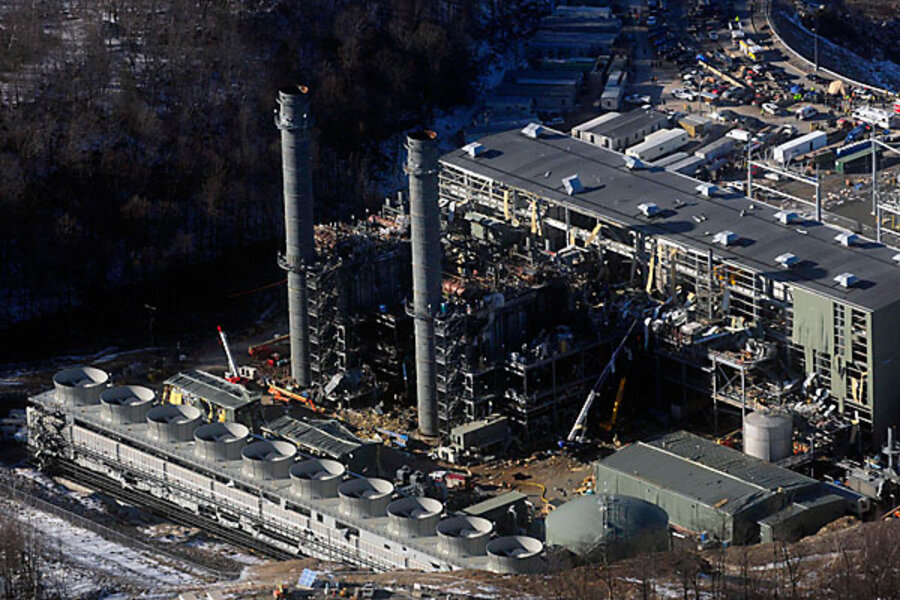US urged new safety standards days before Middletown explosion
Loading...
| New York and Boston
Only three days before the massive explosion that killed at least five workers at a newly constructed natural gas plant in Middletown, Conn., the US Chemical Safety Board (CSB) issued urgent new recommendations on how to prevent explosions when handling or purging natural gas pipelines.
It is too soon to know what happened at Kleen Energy Systems. But workers at the site were reportedly purging a natural gas pipeline prior to the explosion.
In its documentation detailing why it was recommending new safety standards, the CSB cited incidents that show striking similarities to the Connecticut disaster. In at least seven incidents since 1997, workers have died and large-scale damage has been done to buildings as a result of pipelines being purged in an enclosed area.
"We have far more incidents in the database than the half dozen that we have listed," says Sandy Gilmour, a CSB spokesman. "The incidents listed were just the ones that jumped out to our investigators, because they were severe cases or because they could be documented."
According to the CSB, purging of natural gas pipelines is a common occurrence as utilities and other businesses either prepare to begin using natural gas or decommission a pipeline. There are 84 gas-fired turbines in 35 different plants that are either being tested or are still under construction, according to the Edison Electric Institute. A study by the Interstate Gas Association of America Foundation (INGAA) estimates that as many as 62,000 miles of new pipelines could be built in the next 20 years.
Almost all of those new pipelines, as well as the hookups to utilities and industrial companies, will have to go through the process of eliminating air that could mix with the natural gas to become a highly explosive mix. Normally, this process is accomplished by pushing a pressurized inert gas, such as nitrogen or carbon dioxide, through the pipeline before the natural gas is run.
However, according to the CSB documents, this is not always done safely by venting gases outside or having adequate ventilation. One of the major problems appears to be that workers rely on their sense of smell to detect natural gas leaks.
But the human nose very quickly becomes desensitized, resulting in something called “odor fatigue” or “odor fade.” The CSB recommended that purged fuel gases should be directly vented outside, away from people and ignition sources. If it is not possible to vent outside, the CSB recommends that venting inside a building only be done with the proper authorities, such as fire officials, present.
The Chemical Safety Board was created by the Clean Air Act revision of 1990, in part as a response to the Bhopal disaster, in which thousands of people died after toxic gas was released from a pesticide plant in India in 1984. Patterned after the National Transportation Safety Board, the agency has investigatory but no enforcement power. Still, the group has a “bully pulpit” to advocate for changes in safety codes with code-making and regulatory bodies such as the Environmental Protection Agency, says Mr. Gilmour.
Last June, the CSB began investigating a gas line purging at the ConAgra Slim Jim production facility in Garner, N.C., after an explosion killed four people and sent 67 others to the hospital.
The massive explosion caused serious structural damage to the approximately 87,000 square foot facility. About two-thirds of the roof collapsed or became unstable and the explosion damaged piping connected to the plant’s large ammonia-based refrigeration system, releasing some of the toxic gas. The cause of the explosion was improper purging of natural gas by a contractor. The report found the employees used their sense of smell to determine if the job was complete.
Other purging incidents cited by the CSB include a natural gas explosion in May 2008 during the construction of a 30-story Hilton Hotel in San Diego, Calif., that injured 14 workers, and a February 1999 explosion at the Ford Rouge power plant in Dearborn, Mich., that killed six workers and injured 38.
Last week, the CSB went to Raleigh, N.C., to present their case to the National Fire Protection Association (NFPA) to adopt the new regulations. They will also present their recommendations to the American Gas Association and the International Code Council.
Christina Sames, vice president of safety and operations for the AGA, says she has not had a chance to review the entire CSB report, but will. "The code is already pretty clear," she says. "But if changes have to be made to make it even better, we will work with the NFPA."
Follow us on Twitter.





